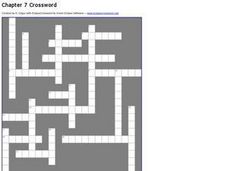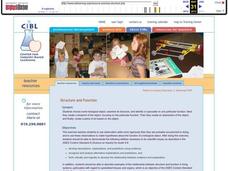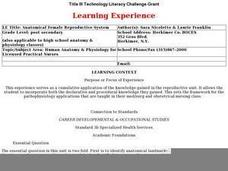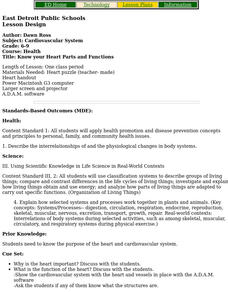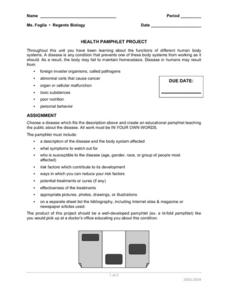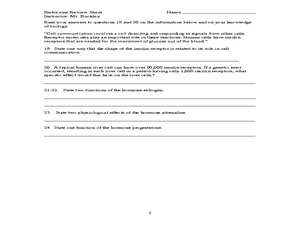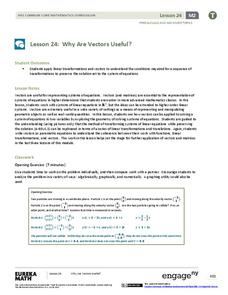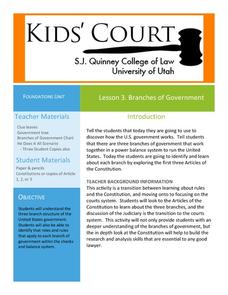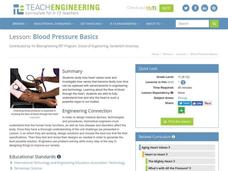Curated OER
Digestive System Crossword
In this digestive system worksheet, students complete a crossword puzzle by figuring out the vocabulary words associated with the 21 clues given.
Curated OER
The Circulatory System
In this circulatory system worksheet, students read a paragraph about the function of the different organs that make up the circulatory system. Then students complete 3 short answer questions.
Curated OER
Structure and Function
Structure and Function
SynopsisStudents choose some biological object, examine its structure, and identify or speculate on one particular function. Next they create a blueprint of the object, focusing on the particular function. Then...
Curated OER
Cell Structure and Function
Tenth graders define and identify the cell membrane functions and structures. They study cell membrane properties" lipid bilayer" and explore cells under the microscope. They draw what they see, label any parts they can identify, and...
Curated OER
Anatomical Female Reproductive System
Students dissect internal female reproductive organs and take digital pictures that are exported onto a disc for use with power point technology.
Curated OER
Is it Legal? - The Judicial System
Fourth graders explore the judicial branch of government; in particular, Florida's judicial branch of government.
Curated OER
Know your Heart Parts and Functions
Middle schoolers put together a 3-D interactive "heart" puzzle and learn the names of heart parts.
Curated OER
Immune System Function
Students study the different facets of the Human immune system, including the functions of all the different organs in the immune system.
Curated OER
What's For Lunch? (Digestive System)
Students identify components of the digestive system and explain functions. They create and label a diagram of the digestive system. They watch the video "Passage of Food" and perform a proper dissection of a frog. They create a flow map...
Curated OER
Skeletal System
Students discuss the need for humans to have a skeletal system and what would happen if we did not have bones. In this skeletal system lesson, students label each bone in the human skeletal system as a group, and then...
Curated OER
Introduction to the Digestive System
Students describe the digestive system and simulate what happens to food as it passes through. They use an apple, tubing and hydrochloric acid to simulate the digestive process.
Curated OER
The Skeletal System
Students identify bones off a skeleton during quizzes; assemble disarticulated skeletons; bird, frog and rat. They dissect frogs, remove the muscle tissue, and identify of bones.
EduGAINs
Go Eco! Ecosystems
How is a movie theater like a desert biome? Compare systems to ecosystems with a set of activities that focuses on accessing multiple intelligences and building upon knowledge. As learners discuss the ways elements of an ecosystem depend...
Explore Biology
Health Pamphlet Project
Biology or health nuts select a disease to research and produce a pamphlet that can be used to inform the public. The tri-fold product is worth 100 points according to the included grading page.
Curated OER
Endocrine Review Sheet
Starting with a diagram of the kidneys and urinary tract of the human, this sheet has questions about excretion, blood concentrations of hormones, gland feedback mechanisms and the effects of some hormones.
Teach Engineering
Cell Celebration!
Are you eukaryotic? (Answer: Yes.) The first of six installments in the Cells units teaches pupils about the similarities and differences of prokaryotes and eukaryotes. It also covers the functions of various cell components in both...
EngageNY
Why Are Vectors Useful? 2
Investigate the application of vector transformations applied to linear systems. Individuals use vectors to transform a linear system translating the solution to the origin. They apply their understanding of vectors, matrices,...
Curated OER
Lesson 3: Branches of Government
Young historians climb through the three branches of the US government in the third lesson of this five-part series. While reading the first three Articles of the Constitution in small groups, children write facts on paper leaves...
Serendip
Homeostasis, Negative Feedback, and Positive Feedback
So many bodily activities depend on homeostasis! Give learners a solid background to understand the basic process of the human body. Scholars first examine negative feedback loops contributing to body temperature regulation and then a...
Teach Engineering
Blood Pressure Basics
Under pressure! The second lesson of the series introduces the class to blood pressure and the impact of high blood pressure on the cardiovascular system. It helps learners make the connection between blood pressure and how the heart...
Georgia Standards
Sociology Unit Six: Socialization Within the Group
How do we learn the rules of society? How do beliefs and ideas affect these rules? Introduce your young sociologists to the factors that socialize individuals with a unit that uses observation and experimentation to analyze how factors...
Tech Museum of Innovation
Seed Dispersal
Engineering challenges are not just man-made ... nature has its own set of them. A hands-on STEM activity has groups designing a seed dispersal system. Each group can only use one sheet of paper — a tough task!
Utah Education Network (UEN)
Utah Open Textbook: 7th Grade Science
Physical and biological factors affect everyday living. Scholars explore electromagnetic forces, motion, the rock cycle, and geological changes. They examine cells as the building blocks of life and how organisms reproduce using images...
Curated OER
Anatomy and Physiology
Fifth graders work in teams to play a game enabling them to identify the basic components of the female human reproductive system. They view an overhead that describes menstruation and discuss their knowledge of the female reproductive...
